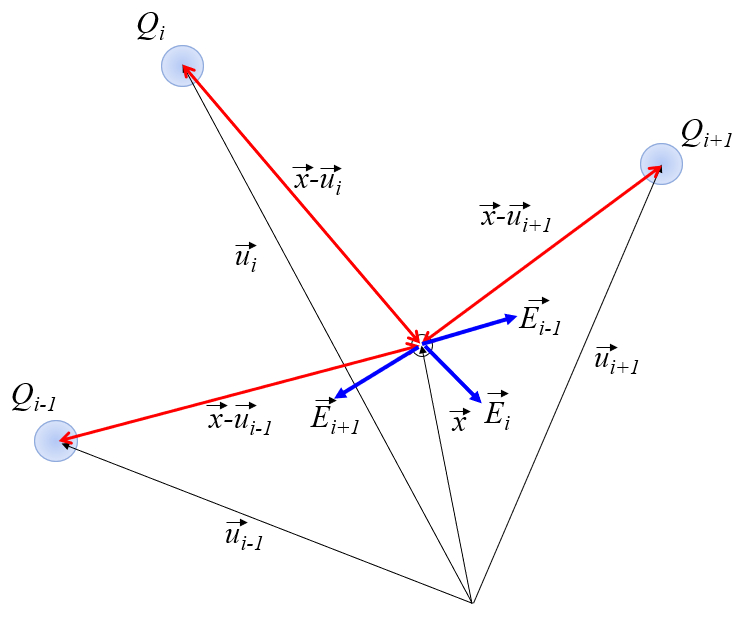Electric field
Storyboard
As loads generate forces, a load distribution will act on a load that positions one at any point in space. In other words there is a 'field' that is a force at any point in space. This force depends on the charge we expose, so it makes sense to define a force per charge so that it is independent of the particle's charge that we seek to study its behavior. Therefore it is possible to define what we call an electric field that is the total sum of all Coulomb forces of the distributed charges divided by the charge of the particle from which the behavior is being studied.
ID:(814, 0)
Electric field
Description
Electric charges generate electric fields that in turn are capable of affecting their behavior. In other words, we are studying the system, affecting its behavior with our intervention. If I measure Coulomb's strength
| $ F =\displaystyle\frac{1}{4 \pi \epsilon_0 \epsilon }\displaystyle\frac{ q Q }{ r ^2}$ |
with it includes a
ID:(790, 0)
Electric field
Equation
If I want to study the system without the
| $ F =\displaystyle\frac{1}{4 \pi \epsilon_0 \epsilon }\displaystyle\frac{ q Q }{ r ^2}$ |
I must separate what is the test load from the rest that we will call the electric field
The electric field generates
| $ F = q E $ |
ID:(3872, 0)
Test Charge
Equation
To measure the strength of Coulomb it is required to introduce a test load into the system. If this load is
| $ \vec{E} =\lim_{q\rightarrow 0}\displaystyle\frac{ \vec{F} }{ q }$ |
ID:(3724, 0)
Electric field of a point charge
Equation
With the Coulomb force of a charge with it is
| $ F =\displaystyle\frac{1}{4 \pi \epsilon_0 \epsilon }\displaystyle\frac{ q Q }{ r ^2}$ |
and the definition of the electric field with charge $C$, electric eield (vector) $V/m$ and force (vector) $N$ as
| $ \vec{E} =\lim_{q\rightarrow 0}\displaystyle\frac{ \vec{F} }{ q }$ |
obtained with charge $C$, electric eield (vector) $V/m$ and force (vector) $N$
| $ E =\displaystyle\frac{1}{4 \pi \epsilon_0 \epsilon }\displaystyle\frac{ Q }{ r ^2}$ |
ID:(11379, 0)
Electric field for various charges
Image
When there are several charges, multiple Coulomb forces must be added in order to obtain the total force:

ID:(11378, 0)
Electric field distribution of charges
Equation
Si existen
| $ \vec{F} =\displaystyle\frac{1}{4 \pi \epsilon_0 \epsilon }\sum_i^N\displaystyle\frac{ q Q_i }{| \vec{r} - \vec{u}_i |^3}( \vec{r} - \vec{u}_i )$ |
que con la definición del campo eléctrico con charge $C$, electric eield (vector) $V/m$ and force (vector) $N$
| $ \vec{E} =\lim_{q\rightarrow 0}\displaystyle\frac{ \vec{F} }{ q }$ |
se tiene que el campo eléctrico de una distribución de cargas con charge $C$, electric eield (vector) $V/m$ and force (vector) $N$ es
| $ \vec{E} =\displaystyle\frac{1}{4 \pi \epsilon_0 \epsilon }\sum_ i ^ N \displaystyle\frac{ Q_i }{| \vec{x} - \vec{u}_i |^3}( \vec{x} - \vec{u}_i )$ |
ID:(3726, 0)
0
Video
Video: Electric field
